Enrichment Characteristics and Mechanisms of Lithium, Gallium, and Rare Earth Elements (REY) within Late Permian Coal-Bearing Strata in Wanfu Mine, Xian’an Coalfield, Guangxi Province, Southwest China
Abstract
1. Introduction
2. Geological Setting
3. Samples and Analytical Procedures
4. Results
4.1. Mineralogy
4.1.1. Minerals in Samples
4.1.2. Mode of Occurrence of Minerals
4.2. Geochemistry
4.2.1. Major Element Oxides
4.2.2. Trace Elements
4.2.3. Rare Earth Element and Yttrium (REY)
5. Discussion
5.1. Sediment Source Region
5.2. Volcanic Ash
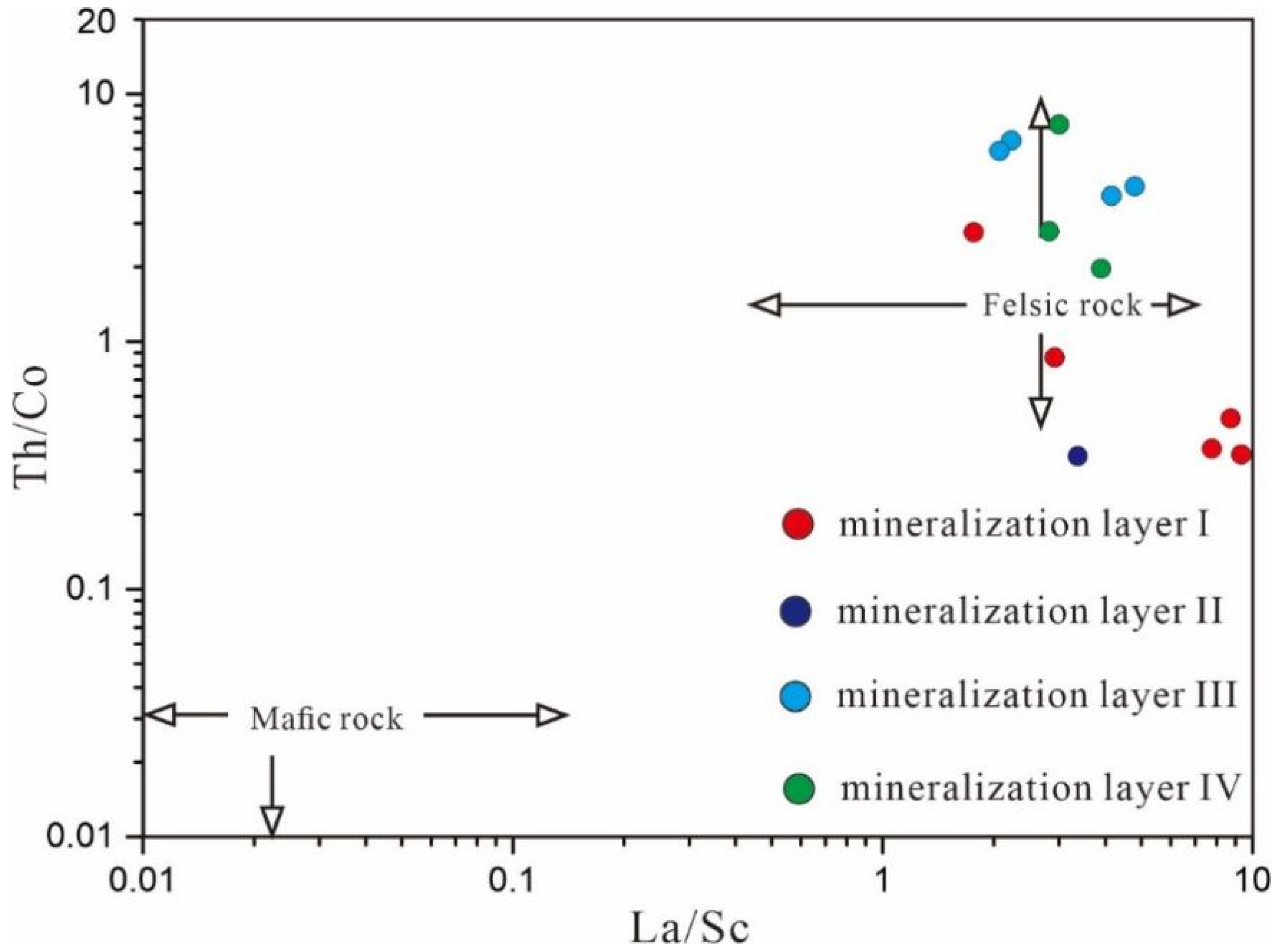
5.3. Hydrothermal Fluids
6. Conclusions
Author Contributions
Funding
Data Availability Statement
Acknowledgments
Conflicts of Interest
References
- Hou, Z.; Chen, J.; Zhai, M. Current status and frontiers of research on critical mineral resources. Chin. Sci. Bull. 2020, 65, 3651–3652. [Google Scholar] [CrossRef]
- Mao, J.; Zeng, Z.; Li, T.; Yuan, S.; Xie, G.; Song, S.; Zhou, Q.; Gao, Y.; Liu, X.; Fu, X.; et al. New advances on metallogenic studies and exploration on critical minerals of China in 21st century. Miner. Depos. 2019, 38, 935–969. [Google Scholar]
- Zhai, M.; Wu, F.; Hu, R.; Jiang, S.; Li, W.; Wang, R.; Wang, D.; Qi, T.; Qin, K.; Wen, H. Critical metal mineral resources: Current situation and problems. Sci. Found. China 2019, 33, 106–111. [Google Scholar]
- Wang, D. Research significance of key minerals, determination of mineral species, resource properties, prospecting progress, existing problems and main direction of attack. Acta Geol. Sin. 2019, 93, 1189–1209. [Google Scholar]
- Seredin, V.; Dai, S.; Sun, Y.; Chekryzhov, I.Y. Coal deposits as promising sources of rare metals for alternative power and energy-efficient technologies. Appl. Geochem. 2013, 31, 1–11. [Google Scholar] [CrossRef]
- Dai, S.; Liu, C.; Zhao, L.; Liu, J.; Wang, X.; Ren, D. Stratagic Metal Resources in Coal-bearing Strata: Significance and Challenges. J. China Coal Soc. 2022, 47, 1743–1749. [Google Scholar]
- Dai, S.; Zhao, L.; Wei, Q.; Song, X.L.; Wang, W.F.; Liu, J.J.; Duan, P.P. Resources of critical metals in coal-bearing sequences in China: Enrichment types and distribution. Chin. Sci. Bull. 2020, 65, 3715–3729. (In Chinese) [Google Scholar] [CrossRef]
- Dai, S.; Yan, X.; Ward, C.; Hower, J.C.; Zhao, L.; Wang, X.; Zhao, L.; Ren, D.; Finkelman, R.B. Valuable elements in Chinese coals: A review. Int. Geol. Rev. 2018, 60, 590–620. [Google Scholar] [CrossRef]
- Liao, J.; Zhang, F.; Wei, M.; Liang, X. Lithium and gallium abundance and enrichment factors in typical Late Permian coal accumulation basins in Guangxi. Coal Geol. Explor. 2020, 48, 77–84. [Google Scholar]
- Dai, S.; Zhang, W.; Seredin, V.V.; Ward, C.R.; Hower, J.C.; Song, W.; Wang, X.; Li, X.; Zhao, L.; Kang, H.; et al. Factors controlling geochemical and mineralogical compositions of coals preserved within marine carbonate successions: A case study from the Heshan Coalfield, southern China. Int. J. Coal Geol. 2013, 109, 77–100. [Google Scholar] [CrossRef]
- Shao, L.; Jones, T.; Gayer, R.; Dai, S.; Li, S.; Jiang, Y.; Zhang, P. Petrology and geochemistry of the high-sulphur coals from the Late Permian carbonate coal measures in the Heshan Coalfield, southern China. Int. J. Coal Geol. 2003, 55, 1–26. [Google Scholar] [CrossRef]
- Dai, S.; Zhang, W.; Ward, C.R.; Seredin, V.V.; Hower, J.C.; Li, X.; Song, W.; Wang, X.; Kang, H.; Zheng, L.; et al. Mineralogical and geochemical anomalies of late Permian coals from the Fusui Coalfield, Guangxi Province, southern China: Influences of terrigenous materials and hydrothermal fluids. Int. J. Coal Geol. 2013, 105, 60–84. [Google Scholar] [CrossRef]
- Zhang, F.; Li, B.; Zhuang, X.; Querol, X.; Moreno, N.; Shangguan, Y.; Zhou, J.; Liao, J. Geological Controls on Enrichment of Rare Earth Elements and Yttrium (REY) in Late Permian Coals and Non-Coal Rocks in the Xian’an Coalfield, Guangxi Province. Minerals 2021, 11, 301. [Google Scholar] [CrossRef]
- Zhou, H. Permian System in Guangxi; China University of Geosciences Press: Wuhan, China, 2014. [Google Scholar]
- Zhang, P.; Shao, L. Sedimentary facies zones and sedimentary models of Heshan Formation, Heshan Area, Guangxi. Acta Sedimentol. Sin. 1990, 8, 9. [Google Scholar]
- Wang, G.; Wen, X. Sedimentary facies analysis of Late Permian Heshan Formation in Guangxi. Curr. Geol. 1995, 1, 119–127. [Google Scholar]
- Karayigit, A.; Bircan, C.; Oskay, R.; Türkmen, I.; Querol, X. The geology, mineralogy, petrography, and geochemistry of the Miocene Dursunbey coal within fluvio-lacustrine deposits, Balıkesir (Western Turkey). Int. J. Coal Geol. 2020, 228, 103548. [Google Scholar] [CrossRef]
- Kortenski, J.; Sotirov, A. Petrography of the Neogene lignite from the Sofia basin, Bulgaria. Int. J. Coal Geol. 2004, 57, 117–126. [Google Scholar] [CrossRef]
- Rao, C.; Gluskoter, H. Occurrence and distribution of minerals in Illinois coals. Ill. State Geol. Surv. Circ. 1973, 476, 56. [Google Scholar]
- Grigoriev, N. Chemical Element Distribution in the Upper Continental Crust; UBRAS: Ekaterinburg, Russia, 2009; p. 382. (In Russian) [Google Scholar]
- Dai, S.; Seredin, V.; Ward, C.; Hower, J.C.; Xing, Y.; Zhang, W.; Song, W.; Wang, P. Enrichment of U–Se–Mo–Re–V in coals preserved within marine carbonate successions: Geochemical and mineralogical data from the Late Permian Guiding Coal-field, Guizhou, China. Miner. Depos. 2015, 50, 159–186. [Google Scholar] [CrossRef]
- Taylor, S.R.; McLennan, S.M. The Continental Crust: Its Composition and Evolution; Blackwell: Hoboken, NJ, USA, 1985; p. 312. [Google Scholar]
- Seredin, V.; Dai, S. Coal deposits as potential alternative sources for lanthanides and yttrium. Int. J. Coal Geol. 2012, 94, 67–93. [Google Scholar] [CrossRef]
- Hayashi, K.; Fujisawa, H.; Holland, H.; Ohmoto, H. Geochemistry of ~1.9 Ga sedimentary rocks from northeastern Labrador, Canada. Geochim. Cosmochim. Acta 1997, 61, 4115–4137. [Google Scholar] [CrossRef] [PubMed]
- Girty, G.; Ridge, D.; Knaack, C.; Johnson, D.; Al-Riyami, R.K. Provenance and depositional setting of Paleozoic chert and argillite, Sierra Nevada, California. J. Sediment. Res. 1996, 66, 107–118. [Google Scholar]
- Li, B.; Zhang, F.; Liao, J.; Li, B.; Zhuang, X.; Querol, X.; Moreno, N.; Shangguan, Y. Geological Controls on Geochemical Anomaly of the Carbonaceous Mudstones in Xian’an Coalfield, Guangxi Province, China. Energies 2022, 15, 5196. [Google Scholar] [CrossRef]
- Cao, B.; Qin, Y.; Zhu, S.; Fu, X.; Xu, H.; Zong, S. Origin and enrichment mechanise of lithium and rare earth elements in carbonaceous mudstone of Heshan Formation, Shanglin, Guangxi. J. China Coal Soc. 2022, 47, 1851–1864. [Google Scholar]
- Liao, J.; Wei, M.; Liang, X. Analysis on Late Permian Heshan Formation Coal Accumulation Basin Lithium Resource Features in Guangxi. Coal Geol. China 2020, 32, 1674–1803. [Google Scholar]
- Dai, S.; Liu, J.; Ward, C.; Hower, J.C.; French, D.; Jia, S.; Hood, M.M.; Garrison, T.M. Mineralogical and geochemical compositions of Late Permian coals and host rocks from the Guxu Coalfield, Sichuan Province, China, with emphasis on enrichment of rare metals. Int. J. Coal Geol. 2016, 166, 71–95. [Google Scholar] [CrossRef]
- Yang, T.; Shen, Y.; Lu, L.; Jin, J.; Huang, W.; Li, F.; Zhang, Y.; Hu, J.; Zeng, L. Geological factors for the enrichment of critical elements within the Lopingian (Late Permian) coal-bearing strata in western Guizhou, Southwestern China: Constrained with whole-rock and zircon geochemistry. Int. J. Coal Geol. 2024, 282, 104441. [Google Scholar] [CrossRef]
- Cullers, R. The geochemistry of shales, siltstones and sandstones of Pennsylvanian–Permian age, Colorado, USA: Implications for provenance and metamorphic studies. Lithos 2000, 51, 181–203. [Google Scholar] [CrossRef]
- Hei, H.; Su, S.; Wang, Y.; Mo, X.X.; Luo, Z.H.; Liu, W.G. Rhyolites in the Emeishan large igneous province (SW China) with implications for plume-related felsic magmatism. J. Asian Earth Sci. 2018, 164, 344–365. [Google Scholar] [CrossRef]
- Xu, Y.; Chung, S.; Shao, H.; He, B. Silicic magmas from the Emeishan large igneous province, Southwest China: Petrogenesis and their link with the end- Guadalupian biological crisis. Lithos 2010, 119, 47–60. [Google Scholar] [CrossRef]
- Hoa, T.; Anh, T.; Phuong, N.; Dung, P.T.; Anh, T.V.; Izokh, A.E.; Borisenko, A.S.; Lan, C.Y.; Chung, S.L.; Lo, C.H. Permo-Triassic intermediate-felsic magmatism of the Truong Son belt, eastern margin of Indochina. C. R. Geosci. 2008, 340, 112–126. [Google Scholar] [CrossRef]
- Zhang, D.; Xu, X.; Sun, J.; Li, B.; Zhang, L.; Zhuang, X.; Yan, X. Geochemical characteristics and provenance of lithium in the Late Permian Heshan Formation coal-bearing series from the Wanfu mining area, Shanglin, Guangxi Province. J. China Coal Soc. 2023, 1178. [Google Scholar]
- Bau, M.; Moeller, P. Rare earth element fractionation in metamorphogenic hydrothermal calcite, magnesite and siderite. Mineral. Petrol. 1992, 45, 231–246. [Google Scholar] [CrossRef]
- Dai, S.; Li, D.; Chou, C.; Zhao, L.; Zhang, Y.; Ren, D.; Ma, Y.; Sun, Y. Mineralogy and geochemistry of boehmite-rich coals: New insights from the Haerwusu Surface Mine, Jungar Coalfield, Inner Mongolia, China. Int. J. Coal Geol. 2008, 74, 185–202. [Google Scholar] [CrossRef]
- Li, B.; Zhuang, X.; Li, J.; Querol, X.; Font, O.; Moreno, N. Geological controls on mineralogy and geochemistry of the Late Permian coals in the Liulong Mine of the Liuzhi Coalfield, Guizhou Province, Southwest China. Int. J. Coal Geol. 2016, 154, 1–15. [Google Scholar] [CrossRef]
- Li, B.; Zhuang, X.; Li, J.; Querol, X.; Font, O.; Moreno, N. Enrichment and distribution of elements in the Late Permian coals from the Zhina Coalfield, Guizhou Province, Southwest China. Int. J. Coal Geol. 2017, 171, 111–129. [Google Scholar] [CrossRef]
- Michard, A.; Albarede, F.; Michard, G.; Minster, J.F.; Charlou, J.L. Rare-earth elements and uranium in high-temperature solutions from East Pacific Rise hydrothermal vent field (13N). Nature 1983, 303, 795–797. [Google Scholar] [CrossRef]
- Michard, A. Rare earth element systematics in hydrothermal fluids. Geochim. Cosmochim. Acta 1989, 53, 745–750. [Google Scholar] [CrossRef]
- Migdisov, A.; Williams, A.; Brugger, J.; Caporuscio, F.A. Hydrothermal transport, deposition, and fractionation of the REY: Experimental data and thermodynamic calculations. Chem. Geol. 2016, 439, 13–42. [Google Scholar] [CrossRef]

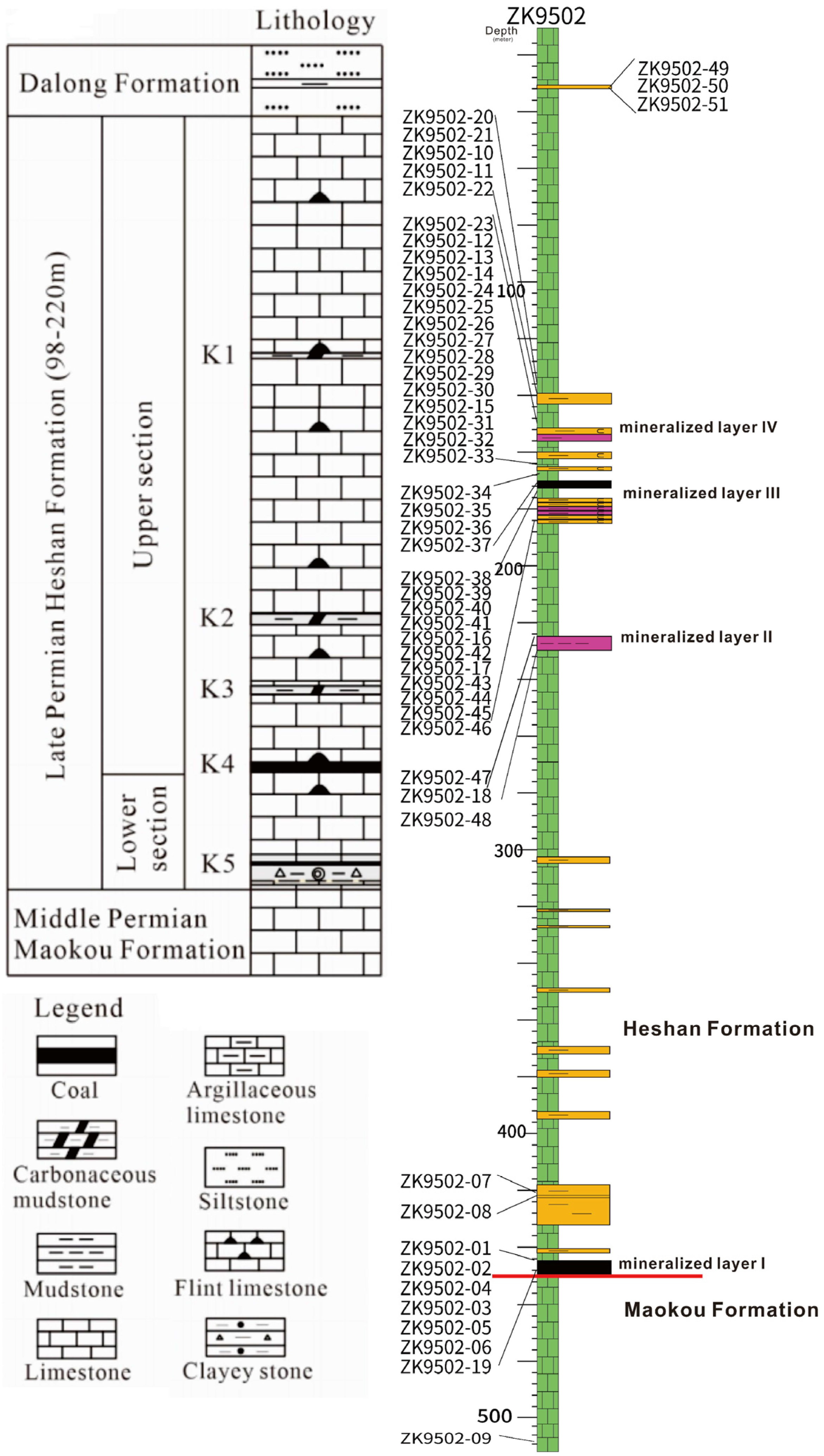

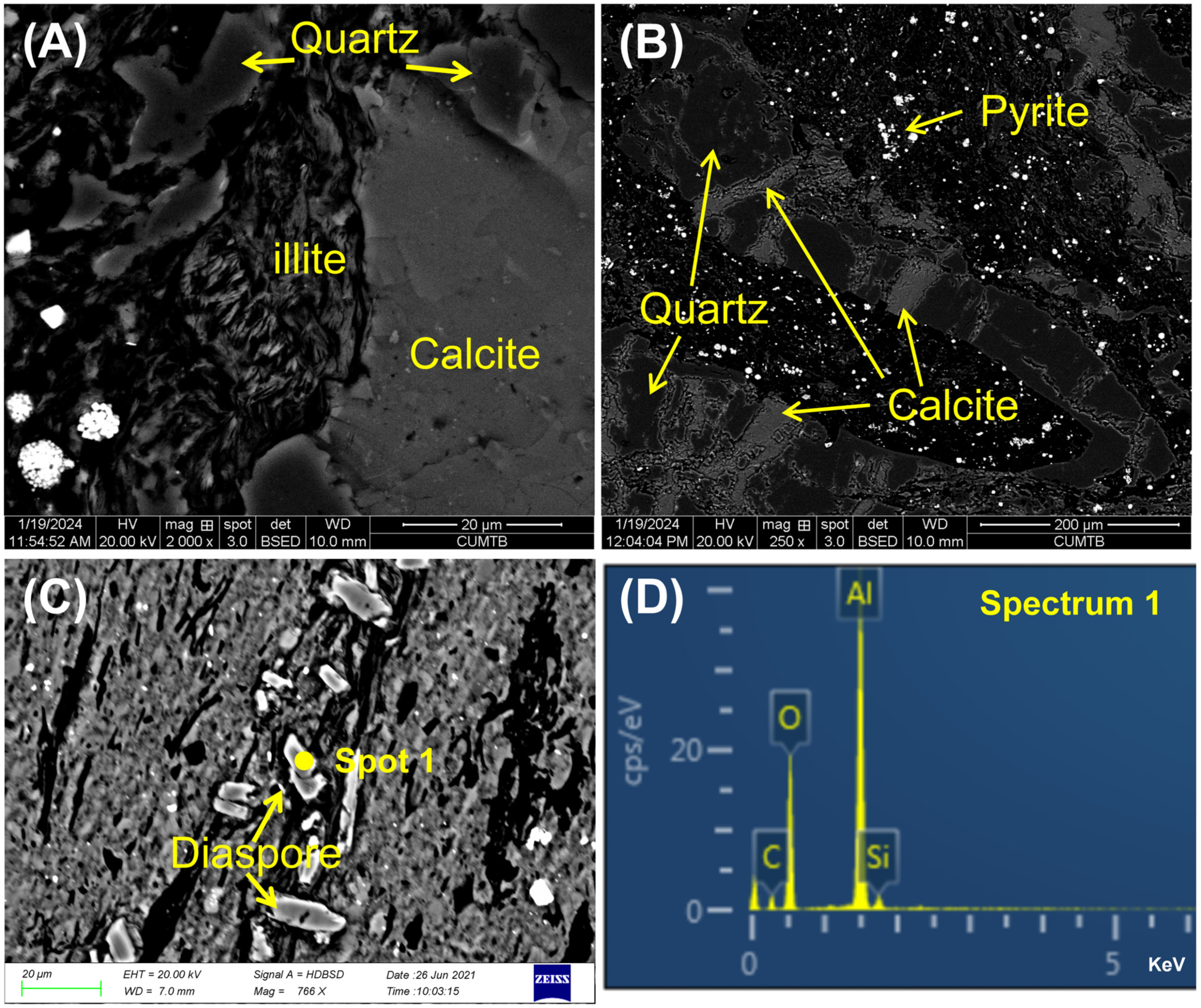
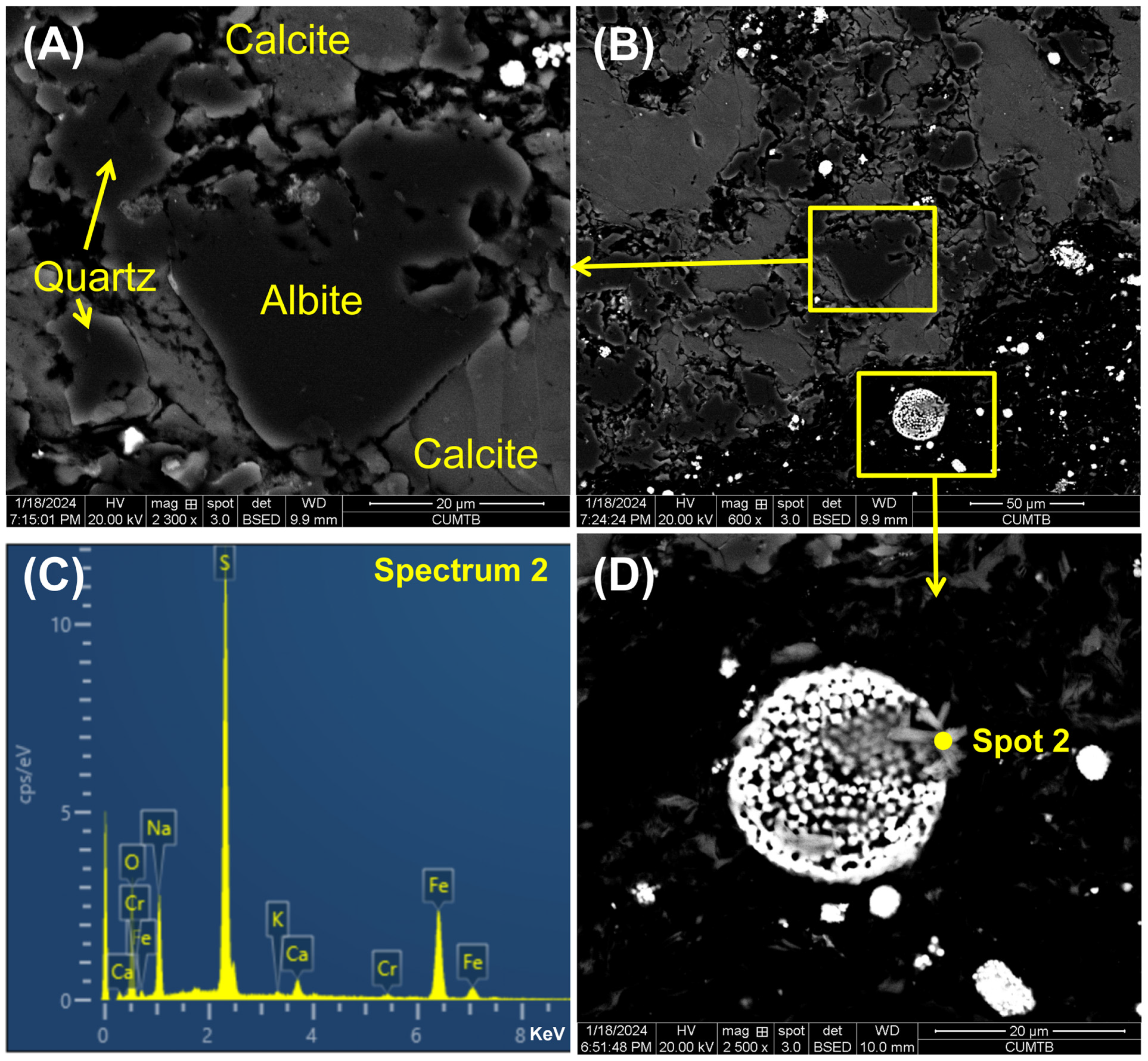
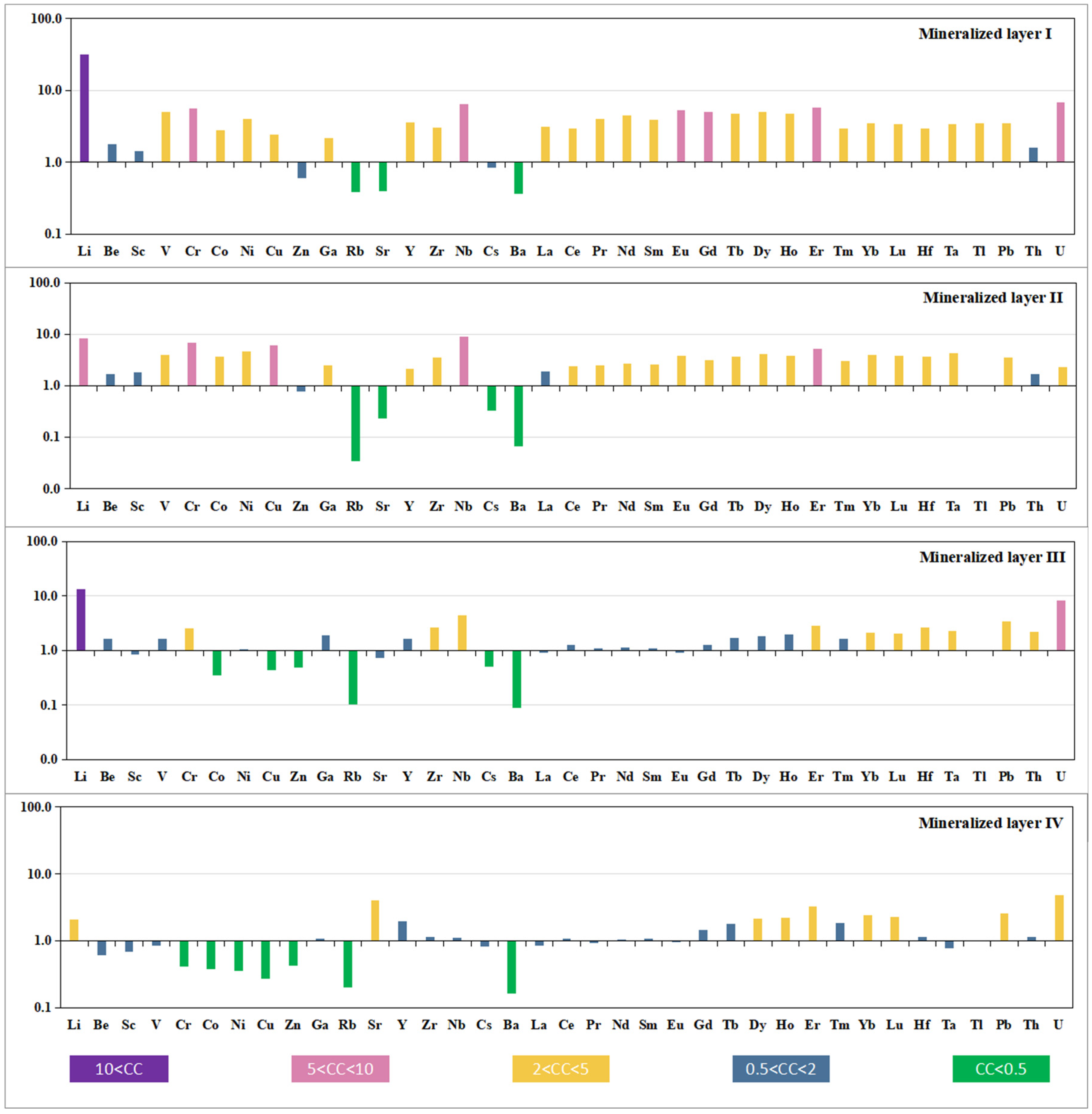


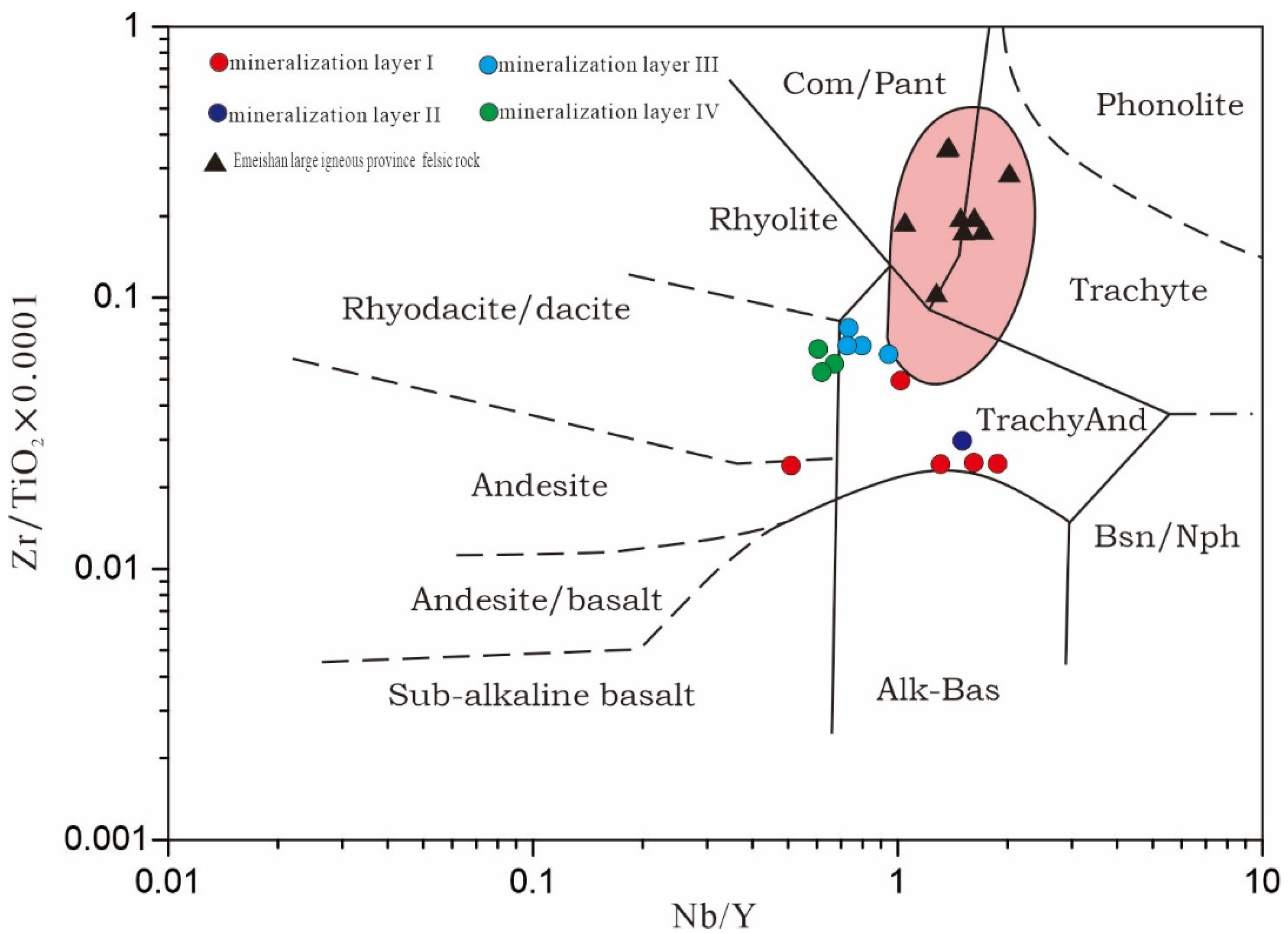
| Sample | Illite | Kaolinite | Clinochlore | Cookeite | Quartz | Calcite | Dolomite | Siderite | Pyrite | Albite | Anatase | Rutile | Diaspore | Bassanite | Melanterite |
|---|---|---|---|---|---|---|---|---|---|---|---|---|---|---|---|
| ZK9502-01 | 95.10 | 1.10 | 3.70 | ||||||||||||
| ZK9502-02 | 37.00 | 2.90 | 20.50 | 1.70 | 28.70 | 0.90 | 4.70 | 3.70 | |||||||
| ZK9502-03 | 44.00 | 12.00 | 1.20 | 18.00 | 2.50 | 0.30 | 20.40 | 1.60 | |||||||
| ZK9502-04 | 41.30 | 34.60 | 17.20 | 5.90 | 1.10 | ||||||||||
| ZK9502-05 | 68.00 | 15.20 | 3.50 | 6.40 | 4.10 | 2.80 | |||||||||
| ZK9502-06 | 53.70 | 35.60 | 1.40 | 6.50 | 2.00 | 0.80 | |||||||||
| ZK9502-07 | 77.10 | 11.40 | 1.70 | 6.70 | 1.80 | 1.30 | |||||||||
| ZK9502-08 | 75.90 | 7.90 | 2.90 | 1.50 | 6.80 | 3.30 | 1.70 | ||||||||
| ZK9502-09 | 95.50 | 4.50 | |||||||||||||
| ZK9502-10 | 68.10 | 5.90 | 3.50 | 22.50 | |||||||||||
| ZK9502-11 | 3.10 | 51.10 | 27.30 | 8.70 | 2.70 | 7.30 | |||||||||
| ZK9502-12 | 39.90 | 47.90 | 2.70 | 6.60 | 0.50 | 2.50 | |||||||||
| ZK9502-13 | 44.60 | 33.50 | 10.40 | 4.30 | 4.30 | 1.90 | 1.10 | ||||||||
| ZK9502-14 | 6.20 | 16.40 | 55.00 | 14.70 | 2.40 | 5.30 | |||||||||
| ZK9502-15 | 3.20 | 8.50 | 42.20 | 3.90 | 7.20 | 8.60 | 23.20 | 0.90 | 2.20 | ||||||
| ZK9502-16 | 12.50 | 79.90 | 2.40 | 1.00 | 3.10 | 0.50 | 0.70 | ||||||||
| ZK9502-17 | 90.00 | 5.20 | 1.10 | 0.80 | 1.00 | 1.90 | |||||||||
| ZK9502-18 | 87.50 | 1.30 | 1.00 | 7.70 | 2.50 | ||||||||||
| ZK9502-19 | 95.60 | 3.00 | 1.30 | ||||||||||||
| ZK9502-20 | 10.50 | 75.60 | 10.90 | 1.80 | 1.10 | ||||||||||
| ZK9502-21 | 11.00 | 57.60 | 31.30 | ||||||||||||
| ZK9502-22 | 19.50 | 72.60 | 2.70 | 0.70 | 4.50 | ||||||||||
| ZK9502-23 | 9.10 | 86.70 | 4.00 | 0.20 | |||||||||||
| ZK9502-24 | 6.20 | 91.60 | 1.20 | 1.00 | |||||||||||
| ZK9502-25 | 12.10 | 84.60 | 1.60 | 1.80 | |||||||||||
| ZK9502-26 | 9.40 | 88.40 | 2.10 | ||||||||||||
| ZK9502-27 | 16.40 | 80.50 | 3.10 | ||||||||||||
| ZK9502-28 | 38.30 | 53.90 | 1.80 | 1.50 | 4.50 | ||||||||||
| ZK9502-29 | 15.50 | 74.80 | 6.00 | 3.70 | |||||||||||
| ZK9502-30 | 24.90 | 22.60 | 39.00 | 6.20 | 1.30 | 6.10 | |||||||||
| ZK9502-31 | 7.20 | 88.60 | 4.30 | ||||||||||||
| ZK9502-32 | 8.20 | 86.20 | 5.60 | ||||||||||||
| ZK9502-33 | 1.40 | 95.90 | 2.70 | ||||||||||||
| ZK9502-34 | 14.20 | 14.10 | 55.60 | 2.10 | 1.80 | 12.20 | |||||||||
| ZK9502-35 | 16.20 | 17.50 | 44.30 | 2.90 | 2.20 | 14.20 | 2.70 | ||||||||
| ZK9502-36 | 7.10 | 24.10 | 57.30 | 5.90 | 2.50 | 3.10 | |||||||||
| ZK9502-37 | 30.30 | 66.60 | 3.10 | ||||||||||||
| ZK9502-38 | 2.90 | 90.70 | 6.40 | ||||||||||||
| ZK9502-39 | 2.70 | 22.00 | 65.20 | 7.60 | 2.50 | ||||||||||
| ZK9502-40 | 4.70 | 90.90 | 4.40 | ||||||||||||
| ZK9502-41 | 9.40 | 5.20 | 4.40 | 76.50 | 4.00 | 0.50 | |||||||||
| ZK9502-42 | 85.70 | 6.80 | 2.50 | 1.90 | 0.90 | 2.20 | |||||||||
| ZK9502-43 | 38.20 | 57.00 | 4.10 | 0.60 | 0.10 | ||||||||||
| ZK9502-44 | 6.90 | 23.40 | 64.10 | 5.10 | 0.50 | ||||||||||
| ZK9502-45 | 6.10 | 92.60 | 1.30 | ||||||||||||
| ZK9502-46 | 5.40 | 4.10 | 79.10 | 9.90 | 1.50 | ||||||||||
| ZK9502-47 | 68.00 | 31.70 | 0.30 | ||||||||||||
| ZK9502-48 | 97.10 | 1.40 | 1.50 | ||||||||||||
| ZK9502-49 | 7.70 | 81.70 | 3.50 | 7.20 | |||||||||||
| ZK9502-50 | 3.60 | 32.70 | 49.30 | 2.50 | 0.90 | 10.90 | |||||||||
| ZK9502-51 | 9.50 | 78.20 | 6.30 | 0.30 | 5.70 |
| Sample | SiO2 | TiO2 | Al2O3 | Fe2O3 | MnO | MgO | CaO | Na2O | K2O | P2O5 | Li | Be | Sc | V | Cr | Co | Ni | Cu | Zn | Ga | Rb | Sr | Zr | Nb |
|---|---|---|---|---|---|---|---|---|---|---|---|---|---|---|---|---|---|---|---|---|---|---|---|---|
| ZK9502-01 | 0.25 | 0.06 | 0.63 | 1.60 | 0.12 | 1.20 | 50.00 | 0.05 | 0.08 | 0.01 | 5.4 | 0.77 | 1.0 | 54 | 54 | 2.8 | 22 | 5.2 | 39 | 2 | 3.4 | 847 | 21 | 2.8 |
| ZK9502-02 | 11.00 | 0.71 | 10.00 | 18.00 | 0.04 | 0.64 | 7.60 | 0.30 | 0.72 | 0.01 | 357 | 2.6 | 12 | 255 | 177 | 8.6 | 61 | 29 | 43 | 22 | 25 | 222 | 433 | 25 |
| ZK9502-03 | 17.00 | 2.90 | 32.00 | 19.00 | 0.03 | 0.30 | 1.10 | 0.38 | 1.40 | 0.01 | 1194 | 5.6 | 23 | 414 | 520 | 9.8 | 42 | 54 | 34 | 52 | 44 | 36 | 703 | 97 |
| ZK9502-04 | 28.00 | 2.70 | 30.00 | 14.00 | 0.03 | 0.44 | 0.56 | 0.52 | 1.60 | 0.02 | 3853 | 7.2 | 24 | 690 | 660 | 108 | 316 | 157 | 57 | 29 | 48 | 39 | 635 | 83 |
| ZK9502-05 | 34.00 | 2.40 | 30.00 | 11.00 | 0.02 | 0.64 | 0.75 | 0.97 | 2.70 | 0.02 | 2052 | 6.2 | 21 | 1133 | 1039 | 79 | 322 | 126 | 76 | 31 | 91 | 53 | 577 | 75 |
| ZK9502-06 | 26.00 | 1.50 | 22.00 | 9.80 | 0.04 | 0.65 | 15.00 | 1.10 | 1.70 | 0.02 | 739 | 4.1 | 24 | 683 | 839 | 80 | 374 | 77 | 84 | 27 | 60 | 211 | 369 | 49 |
| ZK9502-07 | 32.00 | 2.50 | 24.00 | 11.00 | <dl | 0.94 | 7.80 | 0.30 | 4.10 | 0.02 | 19 | 1.4 | 23 | 389 | 499 | 36 | 138 | 73 | 53 | 35 | 137 | 100 | 539 | 72 |
| ZK9502-08 | 33.00 | 2.50 | 25.00 | 11.00 | <dl | 1.20 | 4.00 | 0.36 | 3.90 | 0.02 | 16 | 1.7 | 26 | 441 | 557 | 36 | 160 | 82 | 62 | 38 | 143 | 66 | 603 | 79 |
| ZK9502-09 | <dl | 0.02 | 0.41 | 0.12 | 0.01 | 1.40 | 49.00 | 0.06 | 0.11 | 0.01 | 11 | 0.11 | 0.61 | 33 | 47 | 3.1 | 16 | 1.3 | 21 | 0.27 | 1.3 | 345 | 6.3 | 0.57 |
| ZK9502-10 | 52.00 | 0.21 | 10.00 | 2.10 | 0.24 | 1.90 | 12.00 | 1.20 | 0.59 | 0.03 | 36 | 1.5 | 6.1 | 69 | 23 | 8.2 | 15 | 9.6 | 45 | 11 | 26 | 1135 | 110 | 7.3 |
| ZK9502-11 | 62.00 | 0.30 | 14.00 | 2.50 | 0.09 | 1.80 | 1.70 | 2.10 | 0.69 | 0.07 | 44 | 2.1 | 7.6 | 86 | 40 | 5.3 | 11 | 7.8 | 45 | 16 | 36 | 581 | 165 | 10 |
| ZK9502-12 | 41.00 | 0.35 | 14.00 | 3.20 | 0.04 | 0.62 | 2.10 | 1.00 | 0.64 | 0.02 | 126 | 1.9 | 10 | 79 | 27 | 7.6 | 13 | 11 | 37 | 18 | 27 | 629 | 235 | 13 |
| ZK9502-13 | 40.00 | 0.45 | 17.00 | 2.80 | 0.03 | 1.20 | 4.50 | 0.82 | 0.73 | 0.02 | 140 | 1.9 | 11 | 96 | 37 | 6.8 | 17 | 10 | 39 | 19 | 30 | 695 | 233 | 13 |
| ZK9502-14 | 28.00 | 0.26 | 11.00 | 1.80 | 0.05 | 3.90 | 23.00 | 1.00 | 0.54 | 0.01 | 33 | 1.7 | 8.6 | 139 | 87 | 7.3 | 24 | 7.2 | 36 | 13 | 19 | 2059 | 148 | 9.3 |
| ZK9502-15 | 46.00 | 0.40 | 17.00 | 3.80 | 0.05 | 1.50 | 2.20 | 1.80 | 1.40 | 0.02 | 34 | 3.0 | 13 | 229 | 141 | 5.2 | 44 | 18 | 107 | 21 | 65 | 1219 | 425 | 24 |
| ZK9502-16 | 34.00 | 0.75 | 26.00 | 3.30 | 0.01 | 0.38 | 0.92 | 0.50 | 0.72 | 0.01 | 426 | 4.2 | 13 | 265 | 346 | 7.2 | 55 | 19 | 59 | 28 | 22 | 225 | 493 | 49 |
| ZK9502-17 | 37.00 | 0.94 | 32.00 | 1.40 | 0.01 | 0.19 | 0.22 | 0.19 | 0.30 | 0.01 | 925 | 4.8 | 10 | 178 | 314 | 7.3 | 52 | 13 | 40 | 26 | 8 | 94 | 580 | 48 |
| ZK9502-18 | 22.00 | 2.30 | 19.00 | 7.30 | <dl | 0.30 | 0.67 | 0.18 | 0.19 | 0.01 | 450 | 5.0 | 27 | 484 | 757 | 70 | 225 | 215 | 69 | 40 | 4.6 | 55 | 680 | 98 |
| ZK9502-19 | 1.00 | 0.08 | 1.50 | 8.50 | 0.05 | 1.40 | 67.00 | 0.11 | 0.20 | 0.01 | 6.9 | 0.48 | 4.9 | 23 | 38 | 4 | 21 | 3.6 | 11 | 1.2 | 0.73 | 584 | 11 | 1.2 |
| ZK9502-20 | 15.00 | 0.13 | 3.30 | 1.80 | 0.05 | 2.90 | 36.00 | 0.76 | 0.27 | 0.05 | 7.9 | 0.87 | 3.9 | 17 | 214 | 4.4 | 15 | 16 | 39 | 5.5 | 8.5 | 1063 | 90 | 3.1 |
| ZK9502-21 | 15.00 | 0.03 | 0.97 | 0.56 | 0.06 | 6.70 | 36.00 | 0.22 | 0.11 | 0.03 | 7.1 | 0.75 | 1.7 | 17 | 228 | 2.3 | 31 | 109 | 15 | 1.3 | 2.3 | 1187 | 27 | 1.2 |
| ZK9502-22 | 26.00 | 0.10 | 2.70 | 1.20 | 0.03 | 1.40 | 35.00 | 0.76 | 0.23 | 0.02 | 6.8 | 0.70 | 2.9 | 47 | 336 | 3.7 | 21 | 10 | 23 | 2.7 | 6.1 | 1638 | 33 | 2.6 |
| ZK9502-23 | 11.00 | 0.05 | 1.30 | 0.37 | 0.01 | 1.50 | 44.00 | 0.21 | 0.12 | 0.01 | 4.6 | 0.28 | 2.6 | 54 | 112 | 2.8 | 22 | 11 | 12 | 1.5 | 4.1 | 2011 | 15 | 1 |
| ZK9502-24 | 8.70 | 0.06 | 1.70 | 0.53 | 0.02 | 0.95 | 44.00 | 0.29 | 0.14 | 0.01 | 6.6 | 0.76 | 2.9 | 28 | 76 | 3.2 | 18 | 5.2 | 13 | 2 | 3.6 | 2685 | 24 | 1.6 |
| ZK9502-42 | 39.00 | 1.10 | 37.00 | 2.70 | 0.02 | 0.23 | 1.40 | 0.28 | 0.26 | 0.01 | 1147 | 5.8 | 13 | 123 | 175 | 5.4 | 40 | 13 | 21 | 33 | 5.4 | 140 | 505 | 48 |
| ZK9502-43 | 72.00 | 0.47 | 14.00 | 1.50 | <dl | 0.19 | 2.20 | 0.31 | 0.26 | 0.01 | 980 | 5.9 | 14 | 122 | 184 | 5.6 | 41 | 13 | 22 | 37 | 5.6 | 145 | 428 | 48 |
| Sample | Cs | Ba | La | Ce | Pr | Nd | Sm | Eu | Gd | Tb | Dy | Y | Ho | Er | Tm | Yb | Lu | Hf | Ta | Tl | Pb | Th | U | |
| ZK9502-01 | 0.66 | 12 | 19 | 32 | 3 | 11 | 2.1 | 0.55 | 2.5 | 0.3 | 1.9 | 29 | 0.37 | 0.96 | 0.12 | 0.67 | 0.09 | 0.61 | 0.22 | 0.74 | 2.9 | 1 | 4.7 | |
| ZK9502-02 | 6.4 | 75 | 35 | 103 | 11 | 50 | 11 | 2.8 | 12 | 2.3 | 15 | 119 | 3.3 | 9.7 | 1.2 | 7.2 | 1.1 | 8.5 | 1.7 | 8 | 15 | 7.4 | 35 | |
| ZK9502-03 | 9.9 | 137 | 35 | 110 | 9.2 | 36 | 9.3 | 2.3 | 10 | 1.8 | 13 | 74 | 3 | 9.3 | 1.3 | 8.2 | 1.3 | 18 | 6.3 | 7 | 50 | 27 | 32 | |
| ZK9502-04 | 12 | 160 | 175 | 417 | 53 | 223 | 46 | 9.1 | 42 | 5.5 | 28 | 125 | 5 | 12 | 1.7 | 10 | 1.5 | 17 | 5.5 | 1.8 | 72 | 26 | 28 | |
| ZK9502-05 | 17 | 314 | 333 | 326 | 90 | 360 | 64 | 12 | 56 | 6.9 | 33 | 147 | 5.8 | 14 | 1.7 | 9.7 | 1.4 | 15 | 4.9 | 1.3 | 58 | 27 | 30 | |
| ZK9502-06 | 11 | 210 | 311 | 185 | 70 | 274 | 43 | 9.1 | 42 | 5.4 | 28 | 132 | 5.1 | 12 | 1.6 | 9.3 | 1.3 | 10 | 3.3 | 2.5 | 39 | 18 | 20 | |
| ZK9502-07 | 19 | 388 | 75 | 149 | 19 | 76 | 15 | 2.8 | 13 | 2.1 | 12 | 62 | 2.4 | 7.2 | 1 | 6.6 | 0.97 | 13 | 4.6 | 2.9 | 33 | 19 | 12 | |
| ZK9502-08 | 18 | 420 | 79 | 175 | 21 | 84 | 17 | 3.3 | 15 | 2.3 | 13 | 69 | 2.7 | 7.9 | 1.2 | 7.4 | 1.1 | 15 | 5.2 | 45 | 21 | 13 | ||
| ZK9502-09 | 0.17 | 6.1 | 1.7 | 2.4 | 0.45 | 1.7 | 0.34 | 0.07 | 0.3 | 0.04 | 0.24 | 2.1 | 0.05 | 0.14 | 0.02 | 0.12 | 0.02 | 0.18 | 0.05 | 1.8 | 0.28 | 2.3 | ||
| ZK9502-10 | 5.6 | 195 | 20 | 50 | 4.8 | 18 | 4.5 | 0.8 | 4.6 | 0.72 | 4.5 | 25 | 0.88 | 2.7 | 0.4 | 2.6 | 0.39 | 3.6 | 0.77 | 25 | 12 | 18 | ||
| ZK9502-11 | 11 | 213 | 37 | 75 | 8.3 | 29 | 6.1 | 0.75 | 5.7 | 0.91 | 5.4 | 32 | 1.1 | 3.4 | 0.49 | 3.3 | 0.5 | 5.1 | 1.1 | 28 | 18 | 19 | ||
| ZK9502-12 | 11 | 88 | 39 | 87 | 10 | 41 | 9.1 | 1.2 | 9 | 1.6 | 10 | 71 | 2.2 | 6.9 | 1 | 6.6 | 1 | 5.6 | 0.99 | 36 | 15 | 22 | ||
| ZK9502-13 | 12 | 67 | 31 | 69 | 8.4 | 31 | 7.3 | 0.89 | 7 | 1.2 | 7.7 | 51 | 1.6 | 5 | 0.8 | 5.2 | 0.79 | 6.6 | 1.3 | 40 | 19 | 24 | ||
| ZK9502-14 | 7.5 | 73 | 67 | 101 | 12 | 48 | 11 | 1.8 | 11 | 2 | 12 | 66 | 2.5 | 7.5 | 1.1 | 7 | 0.99 | 4.3 | 0.82 | 26 | 12 | 11 | ||
| ZK9502-15 | 20 | 204 | 30 | 68 | 8.2 | 30 | 6.9 | 0.84 | 6.4 | 1.2 | 7.6 | 42 | 1.6 | 5.1 | 0.78 | 5.2 | 0.79 | 11 | 1.7 | 40 | 23 | 55 | ||
| ZK9502-16 | 7.5 | 61 | 54 | 117 | 13 | 52 | 11 | 1.5 | 10 | 1.9 | 11 | 72 | 2.4 | 7.6 | 1.1 | 7.3 | 1.1 | 12 | 3.5 | 49 | 28 | 51 | ||
| ZK9502-17 | 5.3 | 25 | 48 | 97 | 10 | 40 | 7.9 | 0.95 | 6.6 | 1.1 | 6.5 | 36 | 1.3 | 4 | 0.6 | 3.9 | 0.56 | 16 | 2.6 | 39 | 31 | 24 | ||
| ZK9502-18 | 4.2 | 31 | 91 | 177 | 25 | 98 | 21 | 4.6 | 18 | 3 | 18 | 65 | 3.5 | 10 | 1.5 | 9.8 | 1.5 | 18 | 6 | 50 | 24 | 10 | ||
| ZK9502-19 | 0.18 | 8.4 | 24 | 21 | 8.3 | 38 | 10 | 3 | 16 | 2.7 | 16 | 122 | 3.4 | 9.6 | 1.2 | 6 | 0.83 | 0.37 | 0.11 | 2.1 | 0.4 | 4.9 | ||
| ZK9502-20 | 2.2 | 103 | 8.9 | 18 | 2.5 | 11 | 3 | 0.71 | 3.3 | 0.61 | 3.6 | 23 | 0.8 | 2.3 | 0.38 | 2.3 | 0.35 | 2.1 | 0.2 | 5.3 | 2.4 | 2.7 | ||
| ZK9502-21 | 0.39 | 21 | 3 | 5.7 | 0.7 | 2.8 | 0.74 | 0.17 | 0.93 | 0.18 | 1.1 | 9.8 | 0.27 | 0.76 | 0.13 | 0.79 | 0.12 | 0.52 | 0.08 | 2.1 | 0.93 | 3.4 | ||
| ZK9502-22 | 1.1 | 45 | 8.9 | 15 | 1.9 | 7.3 | 1.6 | 0.28 | 1.5 | 0.26 | 1.4 | 11 | 0.32 | 0.9 | 0.14 | 0.86 | 0.13 | 0.69 | 0.15 | 5.6 | 2.4 | 5.9 | ||
| ZK9502-23 | 0.7 | 26 | 9.2 | 12 | 1.4 | 5.5 | 1.1 | 0.23 | 1.2 | 0.19 | 1 | 9.2 | 0.22 | 0.58 | 0.09 | 0.52 | 0.07 | 0.42 | 0.09 | 4.2 | 1.5 | 7.8 | ||
| ZK9502-24 | 0.94 | 47 | 14 | 21 | 2.5 | 9.8 | 2.5 | 0.53 | 3.8 | 0.77 | 5.3 | 50 | 1.4 | 3.9 | 0.65 | 3.9 | 0.59 | 0.63 | 0.11 | 4.2 | 2.1 | 6.3 | ||
| ZK9502-42 | 5.7 | 24 | 29 | 60 | 6.5 | 24 | 4.8 | 0.61 | 4.3 | 0.86 | 5.1 | 31 | 1.1 | 3.2 | 0.53 | 3.3 | 0.49 | 12 | 3.1 | 52 | 35 | 23 | ||
| ZK9502-43 | 5.8 | 22 | 29 | 61 | 6.7 | 24 | 4.9 | 0.63 | 4.4 | 0.89 | 5.3 | 34 | 1.2 | 3.3 | 0.56 | 3.5 | 0.53 | 13 | 3 | 55 | 33 | 22 |
Disclaimer/Publisher’s Note: The statements, opinions and data contained in all publications are solely those of the individual author(s) and contributor(s) and not of MDPI and/or the editor(s). MDPI and/or the editor(s) disclaim responsibility for any injury to people or property resulting from any ideas, methods, instructions or products referred to in the content. |
© 2024 by the authors. Licensee MDPI, Basel, Switzerland. This article is an open access article distributed under the terms and conditions of the Creative Commons Attribution (CC BY) license (https://creativecommons.org/licenses/by/4.0/).
Share and Cite
Zhang, D.; Yan, X.; Li, B.; Sun, J.; Zhang, L.; Jin, X.; Xu, X.; Di, S.; Huang, S. Enrichment Characteristics and Mechanisms of Lithium, Gallium, and Rare Earth Elements (REY) within Late Permian Coal-Bearing Strata in Wanfu Mine, Xian’an Coalfield, Guangxi Province, Southwest China. Minerals 2024, 14, 853. https://doi.org/10.3390/min14090853
Zhang D, Yan X, Li B, Sun J, Zhang L, Jin X, Xu X, Di S, Huang S. Enrichment Characteristics and Mechanisms of Lithium, Gallium, and Rare Earth Elements (REY) within Late Permian Coal-Bearing Strata in Wanfu Mine, Xian’an Coalfield, Guangxi Province, Southwest China. Minerals. 2024; 14(9):853. https://doi.org/10.3390/min14090853
Chicago/Turabian StyleZhang, Degao, Xiaoyun Yan, Baoqing Li, Jie Sun, Li Zhang, Xiangcheng Jin, Xiaotao Xu, Shaobo Di, and Shaoqing Huang. 2024. "Enrichment Characteristics and Mechanisms of Lithium, Gallium, and Rare Earth Elements (REY) within Late Permian Coal-Bearing Strata in Wanfu Mine, Xian’an Coalfield, Guangxi Province, Southwest China" Minerals 14, no. 9: 853. https://doi.org/10.3390/min14090853
APA StyleZhang, D., Yan, X., Li, B., Sun, J., Zhang, L., Jin, X., Xu, X., Di, S., & Huang, S. (2024). Enrichment Characteristics and Mechanisms of Lithium, Gallium, and Rare Earth Elements (REY) within Late Permian Coal-Bearing Strata in Wanfu Mine, Xian’an Coalfield, Guangxi Province, Southwest China. Minerals, 14(9), 853. https://doi.org/10.3390/min14090853








